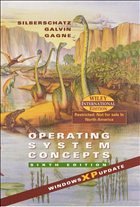Nicht lieferbar

Operating System Concepts
XP Edition
Versandkostenfrei!
Nicht lieferbar
Silberschatz: Operating Systems Concepts, 6/e Windows XP Update Edition, the best selling introductory text in the market, continues to provide a solid theoretical foundation for understanding operating systems. The 6/e Update Edition offers improved conceptual coverage, added content to bridge the gap between concepts and actual implementations and a new chapter on the newest Operating System to capture the attention of critics, consumers, and industry alike: Windows XP.- Brand new chapter on the newest operating system, Windows XP.- Brand new chapter on Threads has been added and includes co...
Silberschatz: Operating Systems Concepts, 6/e Windows XP Update Edition, the best selling introductory text in the market, continues to provide a solid theoretical foundation for understanding operating systems. The 6/e Update Edition offers improved conceptual coverage, added content to bridge the gap between concepts and actual implementations and a new chapter on the newest Operating System to capture the attention of critics, consumers, and industry alike: Windows XP.
- Brand new chapter on the newest operating system, Windows XP.
- Brand new chapter on Threads has been added and includes coverage of Pthreads and Java threads.
- Brand new chapter on Windows 2000 replaces Windows NT.
- Out with the old, in with the new! All code examples have been rewritten and are now in C.
- Client-server models and NFS coverage has been moved to an earlier part of the text.
- More, more, more... The sixth edition now offers increased coverage of small footprint operating systems such as PalmOS and real-time operating systems.
- Updated! Core material in every chapter has been updated, as has coverage of Linux, Solaris and FreeBSD. (20030320)
TAKE THE NEXT STEP IN THE EVOLUTION OF OPERATING SYSTEMS
For the past two decades, dinosaurs have roamed the cover of Silberschatz, Galvin, and Gagne's OPERATING SYSTEMS CONCPETS. The product of a long process of evolutionary adaptations, this best-selling text has continually evolved to address the latest trends in operating system design. With its strong emphasis underlying concepts and rich selection of examples and case studies, no other text provides such a solid theoretical foundation for understanding operating systems.
Now in a fully revised and updated Sixth Edition, OPERATING SYSTEM CONCEPTS offers new chapters on Threads and Windows 2000, as well as new and expanded coverage of the client-server model and NFS, small footprint operating systems for PDAs, real-time operating systems, and more. (20030320)
Table of contents:
1. Introduction.
2. Computer-System Structures.
3. Operating-System Structures.
4. Processes.
5. Threads.
6. CPU Scheduling.
7. Process Synchronization.
8. Deadlocks.
9. Memory Management.
10. Virtual Memory.
11. File-System Interface.
12. File-System Implementation.
13. I/O Systems.
14. Mass-Storage Structure.
15. Distributed System Structures.
16. Distributed File Systems.
17. Distributed Coordination.
18. Protection.
19. Security.
20. The Linux System.
21. Windows 2000.
22. Windows XP.
23. Historical Perspective.
Appendix A: The FreeBSD System (online).
Appendix B: The Mach System (online).
Appendix C: The Nachos System (online). (20030320)
- Brand new chapter on the newest operating system, Windows XP.
- Brand new chapter on Threads has been added and includes coverage of Pthreads and Java threads.
- Brand new chapter on Windows 2000 replaces Windows NT.
- Out with the old, in with the new! All code examples have been rewritten and are now in C.
- Client-server models and NFS coverage has been moved to an earlier part of the text.
- More, more, more... The sixth edition now offers increased coverage of small footprint operating systems such as PalmOS and real-time operating systems.
- Updated! Core material in every chapter has been updated, as has coverage of Linux, Solaris and FreeBSD. (20030320)
TAKE THE NEXT STEP IN THE EVOLUTION OF OPERATING SYSTEMS
For the past two decades, dinosaurs have roamed the cover of Silberschatz, Galvin, and Gagne's OPERATING SYSTEMS CONCPETS. The product of a long process of evolutionary adaptations, this best-selling text has continually evolved to address the latest trends in operating system design. With its strong emphasis underlying concepts and rich selection of examples and case studies, no other text provides such a solid theoretical foundation for understanding operating systems.
Now in a fully revised and updated Sixth Edition, OPERATING SYSTEM CONCEPTS offers new chapters on Threads and Windows 2000, as well as new and expanded coverage of the client-server model and NFS, small footprint operating systems for PDAs, real-time operating systems, and more. (20030320)
Table of contents:
1. Introduction.
2. Computer-System Structures.
3. Operating-System Structures.
4. Processes.
5. Threads.
6. CPU Scheduling.
7. Process Synchronization.
8. Deadlocks.
9. Memory Management.
10. Virtual Memory.
11. File-System Interface.
12. File-System Implementation.
13. I/O Systems.
14. Mass-Storage Structure.
15. Distributed System Structures.
16. Distributed File Systems.
17. Distributed Coordination.
18. Protection.
19. Security.
20. The Linux System.
21. Windows 2000.
22. Windows XP.
23. Historical Perspective.
Appendix A: The FreeBSD System (online).
Appendix B: The Mach System (online).
Appendix C: The Nachos System (online). (20030320)



